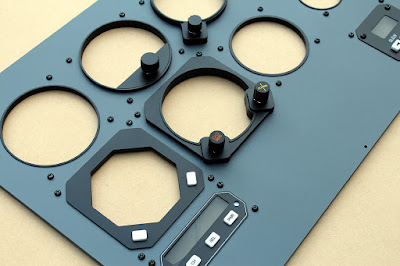[Also, please excuse the variety of colours in these photos, which makes the same panel appear to be different shades of grey in each photo - this was merely a result of poor lighting, poor photography by myself, and poor colour correction!]
The buttons on the above DME bezel are operational and are fitted to a small circuit board that's recessed into the rear of bezel itself, which allows for it to be set away from the surface of the LCD monitor that will be placed behind it (see the photos below for the rear view).
As you can see here, the rear of the encoders are also well forward of the LCD screen's surface whilst still allowing some room for the wiring.
On this occasion we left room for one of our RNS530 units, an operational Altitude Alert System, and six of our Collins-style Dual Radios (as shown partially mocked-up in the next photo). As we try to assemble parts as fully as possible in our workshop prior to shipping, all of the hardware that's shown on this panel has been fitted onto a separate mounting plate which has then been fitted to the rear of the main panel. This hopefully makes installation a little easier ...
In the photo below, because of where the outer limits of the LCD monitors finish, the large switch on the EFIS Aux Power bezel could still protrude out the back of the panel without causing any issues. All of the other buttons have low rear profiles however, so that they can be used on other jobs in the future if necessary.
























































